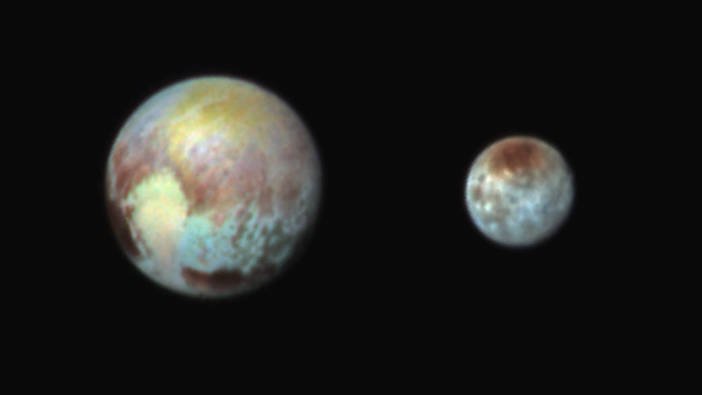Shot of Science: Pluto’s Love Message
In my day Pluto was a planet. One of the nine planets in our solar system I learnt off by heart: Mercury, Venus, Earth, Mars, Jupiter, Saturn, Uranus, Neptune and Pluto. If any planet deserved to be kicked off the special planet list it was Uranus, the butt of all planet jokes. Pluto was way out there at the edge 3.6 billion miles away from the sun. In 2006, the same year the New Horizons spacecraft launched from Earth, Pluto was demoted to a dwarf planet. In 2003 a new object larger than Pluto, named Eris, was discovered just beyond it. Eris caused problems and sparked the debate on what a planet was. It turns out nobody had really defined the term planet before. In the new definition a planet has to orbit the sun and be large enough to have become round due to the force of its own gravity and, sadly for Pluto, it must dominate the neighbourhood around its orbit. Pluto is only about half the width of the United States and one of its moons, Charon, is half Pluto’s size. Pluto is no dominatrix and so the category of dwarf planet was invented.
This week however Pluto felt the love of the inhabitants of planet Earth once more. Fever pitch was reached when the NASA probe sent back its last image of Pluto before going into data-gathering mode on its flyby on Tuesday. Then it was a waiting game as New Horizons did its work for the next 13 hours out of contact with Earth. The excitement in Space is often in the wait. Will it make it? Will it work? Were the calculations correct? New Horizons arrived at its closest point 72 seconds before the calculations predicted but no complications have occurred due to this that we know of. NASA’s photo of Pluto (above) went viral even giving Justin Bieber some competition. The image sent back has been dubbed a love message from Pluto because of the heart like shape on the planet’s surface. Even at minus 375-400 degrees below zero Pluto can still warm our hearts. The first images released by NASA early this morning after New Horizons’ first major data gather show Pluto and its largest moon Charon. This image is altered in colour to make the surface details stand out. Even the two halves of Pluto’s ‘heart’ show compositional differences.

When Pluto was discovered in 1930 Pluto was named via competition by a nine year old girl from Oxford after the Roman God of the underworld because it was dark and far away. New Horizons is bringing Pluto into the light. This is the first Space mission to investigate Pluto and it is hoped that this mission will help us figure out how Pluto and its moons fit into our solar system.
The mission will continue to study Pluto and its moons for the next five months and then other objects in the Kuiper belt (the area in which Pluto is situated) filled with icy objects. So be prepared for more heart-warming photos from Pluto!
In the meantime if all this Space talk has got you excited follow the exciting adventures of Niamh Shaw at the International Space University Space Studies Programme in Ohio right here on HeadStuff!
Cost $700 million
Time taken to get there 9.5 years
Size of New Horizons: 2.5 meters across
Weight: 480 kilograms when first fueled. It’s about the size (and shape) of a baby grand piano.
Weight of a human on Pluto: 7% of their Earth-weight.
New Horizons carries seven scientific instruments:
Alice is an ultraviolet spectrometer used for measuring gas composition
Ralph combines an infrared spectrometer (LEISA) for mapping surface composition with a color optical imager (MVIC) for mapping surface structure and composition
REX is a radio experiment for measuring atmospheric composition and temperature
LORRI is an optical telescope that provides the highest resolution imaging of the surface
PEPSSI is a plasma-sensing instrument for measuring particles escaping from Pluto’s atmosphere
SWAP is a plasma-sensing instrument for measuring the properties of the solar wind at Pluto, Pluto’s atmospheric escape rate, and for searching for a magnetosphere around Pluto. The “solar wind” is a stream of charged particles streaming away from the Sun at high speed.
SDC, an instrument used to measure dust impacts at the New Horizons spacecraft during its entire trajectory, was built by students at the University of Colorado!
